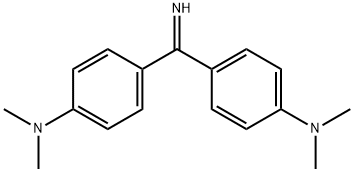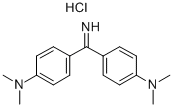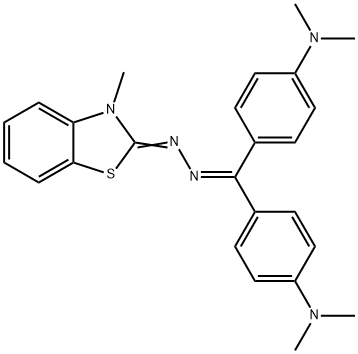Yellow pyoctanine
- CAS NO.:492-80-8
- Empirical Formula: C17H21N3
- Molecular Weight: 267.37
- MDL number: MFCD00036224
- EINECS: 207-762-5
- SAFETY DATA SHEET (SDS)
- Update Date: 2024-12-18 14:15:30

What is Yellow pyoctanine?
Description
Auramine is a yellow crystalline powder or flaky material. Molecular weight= 267.4; Freezing/Meltingpoint=136℃. Hazard Identification (based on NFPA-704M Rating System): Health 3, Flammability 1, Reactivity 0;(hydrochloride) Health 3, Flammability 0, Reactivity 0.Insoluble in water.
Chemical properties
Auramine is a yellow crystalline powder or flaky material.
The Uses of Yellow pyoctanine
Yellow dye for paper, textiles, leather; antisep- tic; fungicide.
Definition
ChEBI: A member of the class of imines that is benzophenone imine carrying two dimethylamino substituents at positions 4 and 4'. The hydrochloride salt is the biological stain 'auramine O'
Preparation
(a) will Sulphur dissolved in 4-(4-(Dimethylamino)benzyl)-N,N-dimethylbenzenamine?methane. Add in ammonia and sodium chloride, ammonia in 175 ℃ heat the mixture, with hot water extraction dye and salting out (GP53614); (b) Bis (4 – (dimethylamino) phenyl) methanone and ammonia and Zinc chloride in a total of 150 ~ 160 ℃ heat (GP 29060). Free base is to add the same amount of naoh aqueous solution hydrochloride, sodium carbonate and ammonia and have to.
General Description
Yellow crystalline powder or yellow needles.
Reactivity Profile
Yellow pyoctanine neutralizes acids in exothermic reactions to form salts plus water. May be incompatible with isocyanates, halogenated organics, peroxides, phenols (acidic), epoxides, anhydrides, and acid halides. May generate hydrogen, a flammable gas, in combination with strong reducing agents such as hydrides.
Hazard
Confirmed carcinogen.
Health Hazard
Inhalation of material may be harmful. Contact may cause burns to skin and eyes. Inhalation of Asbestos dust may have a damaging effect on the lungs. Fire may produce irritating, corrosive and/or toxic gases. Some liquids produce vapors that may cause dizziness or suffocation. Runoff from fire control may cause pollution.
Fire Hazard
Some may burn but none ignite readily. Containers may explode when heated. Some may be transported hot.
Agricultural Uses
Fungicide: Auramine is used industrially as a dye or dye intermediate for coloring textiles, paper, and leather. Also used as an antiseptic (a powerful antiseptic in ear and nose surgery and in gonorrhea treatment)
Trade name
WAXOLINE YELLOW O®
Potential Exposure
Auramine is used industrially as a dye or dye intermediate for coloring textiles; paper, and leather. Also used as an antiseptic (a powerful antiseptic in ear and nose surgery, and treatment of gonorrhea) and fungicide. Human exposure to auramine occurs principally through skin absorption or inhalation of vapors. Low-level dermal exposure to the consumer may occur but would be limited to any migration of auramine from fabric, leather, or paper goods.
First aid
If this chemical gets into the eyes, remove anycontact lenses at once and irrigate immediately for at least15 min, occasionally lifting upper and lower lids. Seek medical attention immediately. If this chemical contacts theskin, remove contaminated clothing and wash immediatelywith soap and water. Seek medical attention immediately. Ifthis chemical has been inhaled, remove from exposure,begin rescue breathing (using universal precautions, including resuscitation mask) if breathing has stopped and CPR ifheart action has stopped. Transfer promptly to a medicalfacility. When this chemical has been swallowed, get medical attention. Give large quantities of water and inducevomiting. Do not make an unconscious person vomit.
storage
Color Code—Blue: Health Hazard/Poison: Store ina secure poison location. Prior to working with auramineyou should be trained on its proper handling and storage.Store in tightly closed containers in a cool, well-ventilatedarea away from oxidizers. Sources of ignition, such as smoking and open flames, are prohibited where this chemical isused, handled, or stored in a manner that could create apotential fire or explosion hazard. A regulated, marked areashould be established where this chemical is handled, used,or stored in compliance with OSHA Standard 1910.1045.
Shipping
UN2811 Toxic solids, organic, n.o.s., Hazard Class: 6.1; Labels: 6.1-Poisonous materials, Technical Name Required. UN3143 Dyes, solid, toxic, n.o.s. or Dye intermediates, solid, toxic, n.o.s., Hazard Class: 6.1; Labels: 6.1-Poisonous materials, Technical Name Required.
Properties and Applications
brilliant green yellow. Soluble in cold water, soluble in hot water for brilliant yellow, boils part decomposition, soluble in ethanol for yellow. In concentrated sulfuric acid to colorless, dilution after buff. The dye for C.I. Basic Yellow 2 free base. Used for oil, paraffin wax, alcohol solvent, alcohol soluble paint, printing ink color.
| Standard | Light Fastness | Heat-resistant(℃) | water | Sodium Carbonate(5%) | Hydrochloric acid(5%) | |
| Melting point | Stable | |||||
| ISO | Poor | 120 |
70≥100
Sublimation |
Poor | Good | General |
Incompatibilities
Incompatible with oxidizers (chlorates, nitrates, peroxides, permanganates, perchlorates, chlorine, bromine, fluorine, etc.); contact may cause fires or explosions. Keep away from alkaline materials, strong bases, strong acids, oxoacids, epoxides.
Waste Disposal
Consult with environmental regulatory agencies for guidance on acceptable disposal practices. Generators of waste containing this contaminant (≥100 kg/mo) must conform with EPA regulations governing storage, transportation, treatment, and waste disposal. Incinerate in furnace with afterburner and scrubber.
Properties of Yellow pyoctanine
| Melting point: | 138℃ |
| Boiling point: | 400.55°C (rough estimate) |
| Density | 1.01 |
| refractive index | 1.6360 (estimate) |
| Colour Index | 41000B |
| pka | 10.12±0.50(Predicted) |
| form | neat |
| BRN | 2215338 |
| CAS DataBase Reference | 492-80-8(CAS DataBase Reference) |
| IARC | 2B (Vol. 1, Sup 7, 99, 100F) 2012 |
| EPA Substance Registry System | Auramine (492-80-8) |
Safety information for Yellow pyoctanine
| Signal word | Warning |
| Pictogram(s) |
 Exclamation Mark Irritant GHS07  Health Hazard GHS08  Environment GHS09 |
| GHS Hazard Statements |
H302:Acute toxicity,oral H319:Serious eye damage/eye irritation H351:Carcinogenicity H411:Hazardous to the aquatic environment, long-term hazard |
| Precautionary Statement Codes |
P202:Do not handle until all safety precautions have been read and understood. P264:Wash hands thoroughly after handling. P264:Wash skin thouroughly after handling. P273:Avoid release to the environment. P301+P312:IF SWALLOWED: call a POISON CENTER or doctor/physician IF you feel unwell. P305+P351+P338:IF IN EYES: Rinse cautiously with water for several minutes. Remove contact lenses, if present and easy to do. Continuerinsing. P308+P313:IF exposed or concerned: Get medical advice/attention. |
Computed Descriptors for Yellow pyoctanine
Yellow pyoctanine manufacturer
New Products
(S)-3-Aminobutanenitrile hydrochloride 4-Methylphenylacetic acid N-Boc-D-alaninol N-BOC-D/L-ALANINOL Tert-butyl bis(2-chloroethyl)carbamate 3-Morpholino-1-(4-nitrophenyl)-5,6-dihydropyridin- 2(1H)-one Furan-2,5-Dicarboxylic Acid Tropic acid 1-Bromo-3,5-Di-Tert-Butylbenzene S-2-CHLORO PROPIONIC ACID ETHYL ISOCYANOACETATE 2-Bromo-1,3-Bis(Dimethylamino)Trimethinium Hexafluorophosphate 4-IODO BENZOIC ACID 3-NITRO-2-METHYL ANILINE 1-(2,4-DICHLOROPHENYL) ETHANAMINE (2-Hydroxyphenyl)acetonitrile 4-Bromopyrazole 2-(Cyanocyclohexyl)acetic acid 4-methoxy-3,5-dinitropyridine 1-(4-(aminomethyl)benzyl)urea hydrochloride 2-aminopropyl benzoate hydrochloride diethyl 2-(2-((tertbutoxycarbonyl)amino) ethyl)malonate tert-butyl 4- (ureidomethyl)benzylcarbamate Ethyl-2-chloro((4-methoxyphenyl)hydrazono)acetateRelated products of tetrahydrofuran




![benzenesulphonic acid, compound with p,p'-carbonimidoylbis[N,N-dimethylaniline]](https://img.chemicalbook.in/CAS/GIF/32783-54-3.gif)
You may like
-
 492-80-8 Auramine base 99%View Details
492-80-8 Auramine base 99%View Details
492-80-8 -
 492-80-8 98%View Details
492-80-8 98%View Details
492-80-8 -
 Auramine CAS 492-80-8View Details
Auramine CAS 492-80-8View Details
492-80-8 -
 1975-50-4 98%View Details
1975-50-4 98%View Details
1975-50-4 -
 2-HYDROXY BENZYL ALCOHOL 98%View Details
2-HYDROXY BENZYL ALCOHOL 98%View Details
90-01-7 -
 2-Chloro-1,3-Bis(Dimethylamino)Trimethinium Hexafluorophosphate 221615-75-4 98%View Details
2-Chloro-1,3-Bis(Dimethylamino)Trimethinium Hexafluorophosphate 221615-75-4 98%View Details
221615-75-4 -
 14714-50-2 (2-Hydroxyphenyl)acetonitrile 98+View Details
14714-50-2 (2-Hydroxyphenyl)acetonitrile 98+View Details
14714-50-2 -
 118753-70-1 98+View Details
118753-70-1 98+View Details
118753-70-1